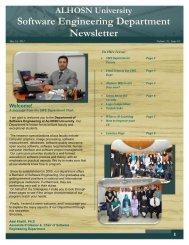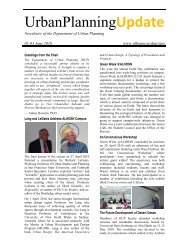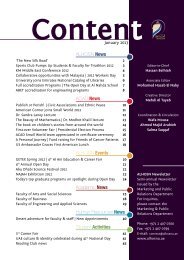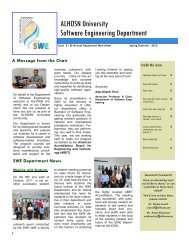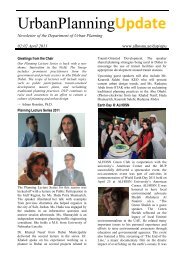ALHOSN University Catalogue Global Knowledge with Local Vision ...
ALHOSN University Catalogue Global Knowledge with Local Vision ...
ALHOSN University Catalogue Global Knowledge with Local Vision ...
You also want an ePaper? Increase the reach of your titles
YUMPU automatically turns print PDFs into web optimized ePapers that Google loves.
Department of Interior Design<br />
Overview<br />
Interior Design plays an active role in creating this context for cultural development and interaction by<br />
establishing the designed conditions <strong>with</strong>in which all human activity takes place. It is a discipline that<br />
embraces the cultural conditions, historical contexts, and symbolic meanings of societies, by creating<br />
relationships between human beings and the constructs of their imagination.<br />
Bachelor of Interior Design (BID)<br />
The Interior Design program seeks to enable students to develop their own expression of ideas through<br />
both verbal and visual development and practice. As producers of interior images, places and<br />
environments, students will define, enhance and transform our vision of an ever-changing world.<br />
The Interior Design program at <strong>ALHOSN</strong> <strong>University</strong> will educate students in the creative activity of<br />
conceptualizing, modifying and realizing the design of space to support human activity and delight,<br />
emphasizing the discipline as an architecturally related program. It is also a program that attempts to<br />
integrate design <strong>with</strong>in the present and future of evolving ideas, technologies and changing cultural<br />
values as an expression of personality, creativity, craft and culture. Providing students <strong>with</strong> a depth of<br />
insight, emerging designers will learn to create alternative design solutions for changing cultural,<br />
economic and social realities. The BID program is modelled after international standards of education,<br />
ensuring students are exposed to the most current developments and approaches in the field of Interior<br />
Design.<br />
Goals<br />
To achieve this mission the program has several goals.<br />
1. To provide a rigorous foundation in both the theory and practice of Interior Design through<br />
an applied studio-based experience, research and field internship.<br />
2. To prepare students to actively engage in the Interior Design profession <strong>with</strong> the confidence<br />
and capability necessary to assume leadership roles in developing creative, expressive, and<br />
habitable interior environments in a variety of applications.<br />
3. To provide a broad contextual understanding of the fundamental aspects of human environment<br />
and culture by offering education in related liberal studies such as sociology, ecology, history,<br />
science and the humanities.<br />
4. To provide knowledge of the processes, technology, and applied techniques utilized in the<br />
planning, design, building and construction of interior space.<br />
5. To give students an understanding of physical, economic, professional and business skills<br />
necessary for Interior Design practice.<br />
Objectives<br />
1. To advance the Interior Design discipline through the research, work, and projects carried out at<br />
the school. To develop evocative and meaningful solutions focusing on the design of interior<br />
spaces, materials, decoration, furniture and fixtures in a variety of contexts and to focus on<br />
teaching a methodology of innovation.<br />
2. To create an emphasis on design, which is responsive to people’s cultural, functional and<br />
aesthetic needs, and that has a beneficial impact on people’s lives by providing a strong foundation<br />
of cultural and design knowledge. To expand the competence of the interior designer to embrace<br />
the behavioural sciences and the understanding of cultural anthropology by assuming the role of<br />
the designer as social innovator.<br />
3. To provide the application of knowledge and theory into practice through the creative and<br />
experiential learning of the studio, and the practical application of theory through materials,<br />
methods, technology and practice.<br />
4. To adopt a design methodology and process of research, analysis, design, and presentation, <strong>with</strong><br />
a strong emphasis on conceptual development, by emphasizing aspects of research, writing and<br />
design theory.<br />
125




